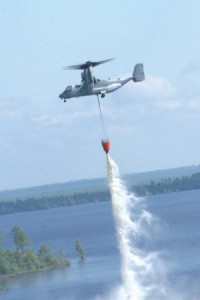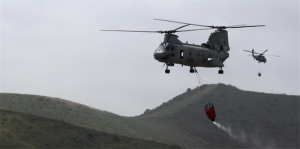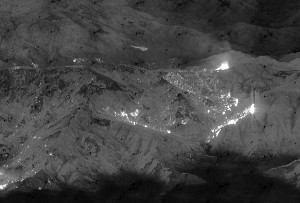 How, exactly, will the MV-22 Osprey–and other new Navy/USMC gear–help at home?
How, exactly, will the MV-22 Osprey–and other new Navy/USMC gear–help at home?
It’s a valid question–Waaay back in 2010-11, when the MV-22 first started to shoulder aside the West Coast’s enormous inventory of venerable, obsolete CH-46 Sea Knights, I started urging the military to get real about evaluating the MV-22’s suitability for HA-DR operations typical to California (wildfires, and, to a lesser extent, post-earthquake support). That sparked a somewhat leisurely series of USMC tests to evaluate the MV-22’s suitability as a water bomber.
I was a pessimist. Back then, during California’s fire seasons, the CH-46 “Phrog” was a ubiquitous presence, doing just about anything and everything to back up California’s stressed state firefighting organization, Cal Fire. Between the old and new USMC platforms, the contrast couldn’t have been starker. While the outdated Phrog demonstrated home-front utility in all sorts of ways, the MV-22 suffered through embarrassing teething problems, systems engineering oversights, and poor reliability. The endless struggles USMC went through to get the platform into the terror fight–all while frantically downplaying the very real fact that very real operational challenges existed–made for a tough contrast with the “get-it-done” CH-46 as existing, albeit elderly Phrog units enjoyed their “last hurrah”.
But the USMC persevered, and, while I still grit my teeth over the MV-22’s reliability rates, high maintenance demands and operating cost, the MV-22 is here to stay and will be a California feature for the next several decades.
So…With that fact in mind, we should all spend some time learning how to use the MV-22 here at home–the capability that left with the CH-46s ain’t coming back. Sure, the new UH-1Y “Venom” Huey is nice, the MH-60 “Seahawk” is fine, and the CH-53K will be awesome when it arrives, but…it’s the MV-22 that is going to be in Southern California. In numbers. Available.
And though some Marines may not like this, for the MV-22 and the USMC as a whole, homeland support work is important. Yeah, it ain’t warfighting, but, for emergency response, California is a national “taste-maker”. It’s been demonstrated time and again–homeland and disaster support concepts developed in the West propagate nationally. If the MV-22 successfully contributes in California, it’ll contribute everywhere. And, on a more self-interested scale, high-profile engagement here at home always yields the Navy and USMC enormous political dividends in Washington, DC.
It turns out that the Osprey will be working at home quite soon. Brian Rokos, a Riverside California Press Enterprise reporter, was lucky enough to observe an MV-22 drilling with CalFire.
He called me for comment, but he also got a nice scoop on the MV-22:
“…it will become available to Cal Fire to fight wildfires starting in May, said Travis Alexander, Cal Fire division chief for tactical air operations.
The MV-22 will be able to respond from Marine Corps Air Station Miramar and Camp Pendleton within 24 hours to fires in Cal Fire’s San Diego Unit. Requests for the Osprey to fight fires in the Inland Empire and elsewhere must go through the Department of Defense and could take 96 hours to be approved.
The aircraft would be called in only when all other Cal Fire resources are tapped out and flames are threatening lives or high-value places such as hospitals, roads or water-treatment plants, Alexander said.
“I couldn’t be happier that California and the Marine Corps are working together to apply this new piece of technology now rather than later,” said Craig Hooper, who has advocated adapting the Osprey for firefighting use on his maritime blog…”
So the MV-22 might get to bomb a fire this year! It’s great to see the Marines and CalFire working together on this, and it will be great to see the Osprey on the fireline.
But to work–really work–in a domestic firefight, the MV-22’s capabilities (speed and range) require that both CalFire–and the Department of Defense–change tactics, so that the power of the DoD is leveraged to prevent things from getting out of control in the first place.
Changing “support to civil authorities” doctrine is a big deal. But it’s needed; more and more of the naval assets in the West are best suited to handle two missions: 1) speedy response and 2) providing situational awareness.
Take the MV-22, for example. As I have said many times before, the MV-22 is no helicopter, and efforts to shoe-horn it into a conventional helicopter “water-drop” role will be unsuccessful–until the MV-22 gets an internal water tank and sprayer, a bambi-bucket-bound MV-22 will prove to be more costly and less-effective than old-school rotary wing craft. But the USMC and CalFire are bound and determined to tether the MV-22 to a water bucket because civil support doctrine hasn’t kept up with the pace of military tech.
If the Osprey had an opportunity to be used at home like USMC doctrine says that it should–it might be a game-changer in wildfire states. Why, policymakers everywhere would perk up if researchers determined that the rate of big fires dropped when strategically-based MV-22’s were employed to speed groups of 24 elite firefighters to emergent blazes. I don’t need data to tell me that getting twice as many boots on the ground twice as fast as CalFire’s go-to Super Hueys is a good thing, and I’m willing to wager that the timely arrival of a trained team will, more often than not, mean the difference between a trivial few-acre fire and a miles-wide, town-threatening conflagration. We just need a pilot project to find out.
Of course there will be some issues; the hot, “fire-starting” MV-22 downdraft might be an issue to manage during red-flag days, but it’s a manageable threat. There are plenty of roads, rocky areas, pastures and other places in your average California landscape where an MV-22 could land without too much risk. Or train the firefighters to fast-rope out and quick-prep a backup LZ. And if infiltration is the MV-22’s “day” job, then fast fire response is more of an opportunity for realistic training than schlepping a bambi bucket back and forth.
But using the MV-22 in this way–landing elite firefighters before a blaze gets out of control–isn’t possible right now. Again–and for all sorts of very good and very valid reasons–civil services can only get access to military support when overwhelmed. CalFire is locked into old, proven operational doctrine, and that old doctrine means CalFire only calls the USMC when it needs water-bombers.
And that leads back to the doctrine question: What if our newest military assets provide the biggest benefit when they have an opportunity for employment in a preventative role? Shouldn’t there be a means for locals to access prevention-based support assets when the situation looks dangerous? Is there a way to recruit military help before a conflagration, and when the risk of a big blaze is likely?
I think so.
I mean, it’s wonderful to have MQ-4C Triton imagery (see above) during a big fire event, but…wouldn’t it be better to have that platform up, identifying emergent hotspots and supporting a fast response when conditions suggest the chance of a dangerous conflagration is high? Wouldn’t it be great to have a fast-response detection-cueing-interdiction stood up when it’s really needed?
Enabling the military to take a proactive stance at home, in support of civil authorities, would be the best fit with current battlefield doctrine and ultimately cost the Nation less (and be less disruptive to the military) than waiting. Sure, detractors will claim that a proactive State and Local dependence upon the military is inherently unhealthy, and that such an arrangement will promote chronic underfunding of firefighting assets, but….these fancy pieces of military-grade kit aren’t anything even the best-funded state firefighting teams are ever gonna buy. They can’t afford it.
If given a chance to experiment, civil authorities might, in time, demand something similar. But I sure don’t see any state tinkering with new doctrine or experimenting with more modern military-esque equipment until 1) they get some experience using military-grade resources and 2) get a chance to build their own requirements set after experiences with new military technology. Give first-responders a taste of what might be possible, and they’ll generate a demand signal that’ll drive prices down and make the tech far more reliable and user friendly. Everybody wins.
At some point, there’s got to be some room to innovate. And California is a perfect place for the Navy to do it.


